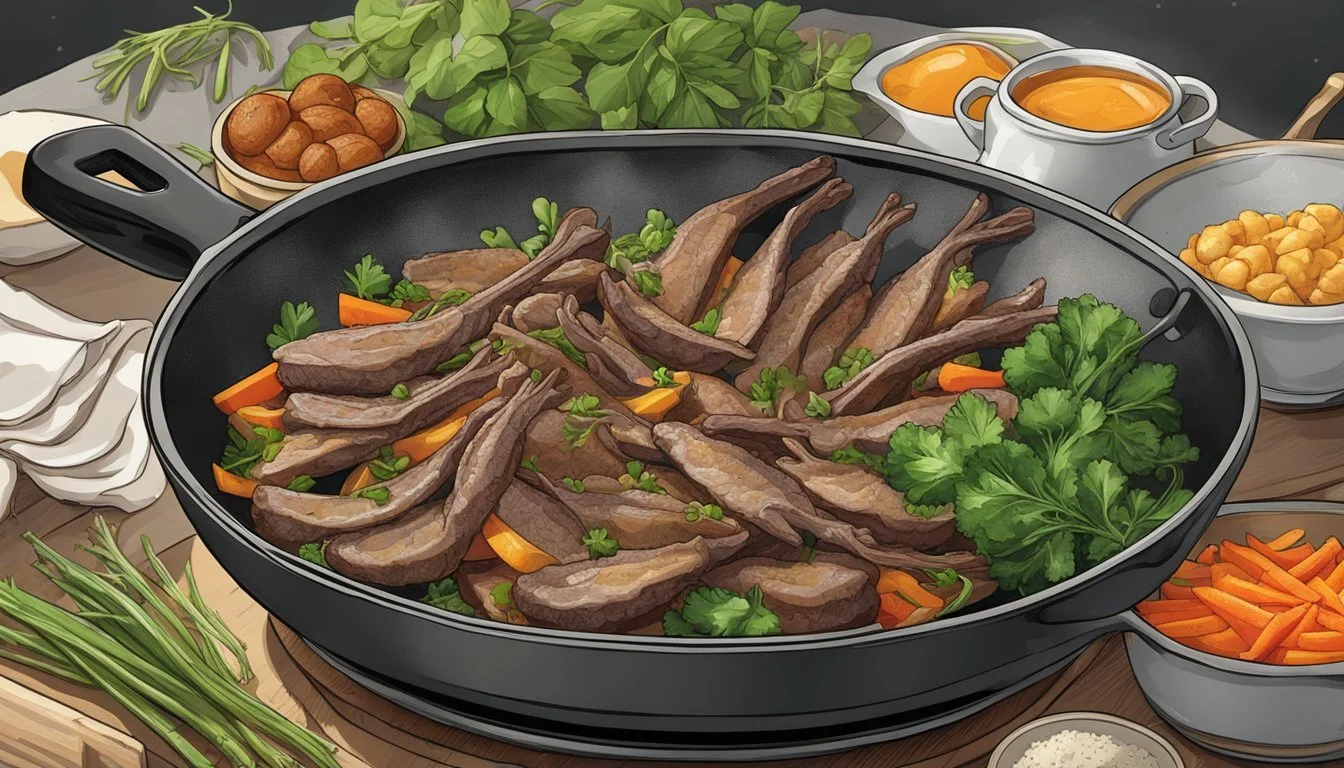Crispy Fried Duck Tongues
Unveiling the Cultural Delicacy
Crispy fried duck (What wine goes well with duck?) tongues are an esteemed delicacy in various culinary traditions, particularly within Chinese cuisine. They embody a unique texture and flavor profile that distinguishes them from more familiar meat cuts. Characterized by their tender yet slightly chewy consistency, duck tongues offer a special eating experience that can be appreciated in its pure form or as part of more complex dishes. The preparation process plays a crucial role in achieving the desired crispiness, often involving marinating and deep-frying to perfection.
While not commonplace in Western kitchens, duck tongues have been long cherished in certain cultures for their taste and texture. These small morsels are meticulously cooked to create a harmonious balance between a crispy exterior and a succulent interior. They are typically served seasoned, much like other savory snacks, and can be found in various street food markets and upscale restaurants across Asia. Often seasoned with aromatic spices and sauces, crispy fried duck tongues are sought after for their ability to marry tradition and flavor in a single bite.
Historical Significance and Cultural Context
In various cultures, particularly in Asia, duck tongues are more than just an exotic ingredient; they embody deep-rooted culinary traditions and cultural significance.
Cultural Significance of Duck Tongues
Duck tongues have secured their place in Chinese gastronomy as an esteemed delicacy. They are often associated with lavish feasts and traditional dining experiences. In Chinese culture, ducks symbolize happiness, fidelity, and unity. These values are reflected in the dishes that include duck tongues, underscoring their cultural importance. Additionally, duck tongues are a staple in Asian markets and grocery stores, indicating their widespread acceptance and demand in regions where these cultural notions prevail.
Regional Variations in Preparation
The preparation of duck tongues can vary significantly across different regions. They are commonly found in Chinese food (What wine goes well with Chinese food?) menus, where they might be seasoned with oyster sauce, ginger, and rice vinegar. Dim Sum, a style of Chinese cuisine served in small bite-sized portions, occasionally features duck tongues, evidencing the versatility of this ingredient. Each regional cuisine brings its unique blend of flavors and cooking techniques to highlight the texture and taste of duck tongues.
Anatomy and Preparation of Duck Tongues
Preparing duck tongues, a delicacy in various cuisines, requires an understanding of their unique anatomy and specialized preparatory techniques to bring out their tender quality and flavors, often enhanced with ingredients like rice wine.
Understanding the Anatomy of Duck Tongues
Duck tongues differ from human tongues in that they contain a piece of hyoid bone near the base. Contrary to popular belief, this isn't a complete bone but rather a small, soft piece of cartilage. The typical structure of a duck tongue comprises of a thin, elongated, and pliable tip, with the bone-like cartilage giving it structure. This combination results in a texture that is tender yet offers some resistance, making it ideal for culinary processes aiming to achieve a crispy exterior while maintaining a succulent interior.
Cleaning and Preparatory Techniques
To prepare duck tongues for cooking:
Rinse and Cleanse: One should thoroughly rinse the tongues under cold water to remove any debris or residual blood.
Remove Cartilage: Carefully detach the cartilage without tearing the tender meat.
Marinade: A typical marinade might include:
Rice wine for its aromatic and flavor-enhancing properties.
Salt to season and help tenderize the meat.
The duck tongues are often left in the marinade for a period, which could range from 30 minutes to several hours, to allow the flavors to penetrate and tenderize the meat further. The use of rice wine is particularly crucial for its tenderizing effect and for imparting a delicate umami flavor typical of many Asian-inspired crispy duck tongue recipes.
Cooking Techniques
In preparing duck tongues, chefs employ a variety of techniques to achieve that perfect texture and flavor. Whether they are deep-fried to golden crispiness or cooked using alternative methods that infuse the meat with aromatic flavors, understanding these methods is essential for any aspiring cook.
Frying and Cooking Duck Tongues
For those seeking a crispy delicacy, deep-frying is a common method. Chefs typically heat cooking oil in a deep pan or wok to approximately 350°F (180°C), then carefully add the duck tongues, which are often coated with egg white and cornstarch prior to frying. The tongues are then fried for about 5 to 6 minutes until they turn golden brown, ensuring a crispy exterior and tender interior. The process is meticulous—one must stir fry and toss almost constantly, preventing burning while achieving an irresistible crispness.
Alternative Cooking Methods
Apart from frying, there are other techniques for cooking duck tongues to bring out different qualities of the meat. For instance:
Braised: Cooks might braise the tongues in a flavorful liquid made with stock, spices, and aromatics such as ginger and Shaoxing wine. They typically seal the duck tongues with ingredients in a vacuum bag and place it in hot water or an oven set between 175°F and 190°F in a sous vide water bath.
Stir Fry: Occasionally, a quick stir fry in a shimmering, hot wok with garlic and a blend of sauces is used to enhance the flavor while keeping the tongues reasonably tender.
Oven Cooking: Although less common for achieving a crispy texture, some chefs may cook them in an oven as part of a slower cooking process that ensures they are fully infused with the flavors of accompanying ingredients.
Seasoning and Flavoring
Proper seasoning is pivotal in turning duck tongues into a flavorful delicacy. This section breaks down the specific spices and sauces to achieve a symphony of taste, ensuring each crispy bite is as tantalizing as the last.
Incorporating Spices and Sauces
For a dish rich in nuanced flavors, spices and sauces play a central role. To begin, chefs commonly season duck tongues with salt and pepper to enhance the natural flavors of the meat. Beyond these basics, garlic and ginger are often added to the mix for their aromatic qualities, creating a fragrant base layer. The addition of soy sauce offers a salty, umami depth, while chili sauce can bring a pleasant heat to the dish.
In addition to these, other sauces such as oyster sauce and sesame oil contribute an Asian flair, each adding their unique blend of sweetness, saltiness, and a hint of nuttiness. For a Western twist, a light brushing of barbecue sauce might be used for a smoky sweetness.
Balancing Flavors
The key to a well-seasoned dish lies in the balance. Aim to achieve a harmonious blend between sweet, salty, spicy, and tangy elements:
Salt: A fundamental seasoning, but must be used judiciously to avoid overpowering the other flavors
Sugar: Sometimes used to offset excessive heat or saltiness, creating a more complex flavor profile
White Pepper: Provides a sharp, earthy heat unlike the more common black pepper
Seasonings and Spices: Should be carefully selected and used in moderation to complement the unique flavor of duck without dominating it
Achieving balance is also dependent on the timing of when these flavorings are added during the cooking process. For instance, sesame oil is often best drizzled over the dish just before serving to preserve its delicate taste and aroma.
Recipe Variations
Duck tongues can be prepared and enjoyed in a variety of ways, each bringing a unique twist to the delicate texture of this delicacy. From classic methods to contemporary fusions, the scope for creativity is vast.
Classic Crispy Fried Duck Tongues
The traditional approach to frying duck tongues involves a simple yet precise process. First, the tongues are typically seasoned with a blend of salt and aromatic spices, then coated with a mixture of egg whites and cornstarch for a light, crispy texture. They are fried in a wok filled with oil heated to 350°F until golden brown. This method highlights the rich flavor inherent in the duck tongues.
Ingredients Used:
Duck tongues
Coarse salt
Egg whites
Cornstarch
Oil for frying (usually duck fat or a neutral-tasting oil like canola)
Key Flavorings:
Rice Vinegar
Tamari or soy sauce
Fish Sauce
Orange Zest
Cooking Notes:
The duck tongues should be marinated prior to frying for enhanced flavor. Tamari can be used for a richer, wheat-free alternative to traditional soy sauce.
Rice vinegar adds a subtle acidity which balances the strong flavors.
Orange zest can introduce a citrusy note, contrasting the savory taste profile.
Innovative Fusion Interpretations
Chefs are constantly reinventing traditional recipes, and duck tongue dishes are no exception. Fusion interpretations often incorporate strong flavors like fish sauce or tamari, along with ingredients not traditionally associated with duck tongues, such as hints of citrus or chili for a kick of heat.
Innovative Pairings:
Pair duck tongues with a glaze made from reduced balsamic vinegar and a touch of honey for a sweet and tangy flavor.
Experiment with seasoning mixes that include spices like five-spice powder or Sichuan peppercorns to create a more complex flavor profile.
Introduce elements like fruit salsas or pickled vegetables (What wine goes well with pickled vegetables?) to complement the richness of the meat.
Experimental Techniques:
Utilize sous vide cooking to tenderize the duck tongues before finishing with a quick fry for crispness.
Integrate the duck tongues into other dishes, such as tacos or sliders, offering an unexpected texture and flavor experience within a familiar format.
Texture and Flavor Balance:
Keep an eye on achieving a balance between the crispy exterior and the tender interior.
Balance strong flavors with acidic or sweet components to create a harmonious dish.
Serving and Presentation
Crispy fried duck tongues, often considered an exotic delicacy, are usually presented with great care to enhance the eating experience. Their crisp texture makes them a popular choice for a bar snack or a party appetizer.
Dish Accompaniments
Vegetables: Thinly sliced carrots and green onions can provide a fresh contrast to the rich flavor.
Starch: They pair well with a simple serving of rice, offering a textural balance.
Sauces: Offer a variety of sauces, such as a tangy dipping sauce or a spicy glaze, to complement their crispy nature.
Presentation for Different Occasions
Informal Gatherings: For casual events, they can be served in a communal bowl,
Health Considerations and Nutritional Information
Duck tongues, when prepared as a crispy fried dish, provide a unique culinary experience. However, consumers should be aware of their health impact and nutritional value. Duck tongues can offer certain nutritional benefits and accommodate dietary preferences but should be consumed in moderation due to their high-fat content, primarily if duck fat is used in the preparation process.
Duck Fat: It is rich in monounsaturated fats, which can be beneficial for cardiovascular health when consumed in place of saturated fats. Duck fat also contains linoleic acid, a type of polyunsaturated fat, but its use should be balanced to avoid excessive intake of fats.
Broth: If duck tongues are cooked in broth, the nutritional value may be enhanced, depending on the ingredients used in the broth. Homemade broth can be a source of minerals and can contribute to the overall depth of flavor without significant caloric addition.
Lean Protein: Duck tongues are a source of lean protein, essential for muscle repair and growth. Moderate consumption of lean protein sources can align with a balanced diet.
Nutritional Benefits: They can include vitamins and minerals inherent in poultry, contributing to a balanced intake of essential nutrients.
Nutrient Potential Benefits Monounsaturated Fats May support heart health Protein Supports muscle maintenance Minerals Involved in various body functions
Individuals considering their caloric intake and dietary limitations should be aware of the cooking method, as frying can significantly increase the calorie count of the dish. Those with dietary restrictions or health concerns should consult with a healthcare provider or a nutritionist to determine whether duck tongues can be a suitable addition to their meals.
Procurement and Sustainability
In some cultures, particularly in Asia, crispy fried duck tongues are considered a delicacy. The procurement of duck tongues and the sustainability of their production are crucial aspects of this market.
Sourcing Duck Tongues
Duck tongues are primarily sourced from poultry farms that raise ducks for various purposes, including meat and egg production. Many of these farms are located in Asia, where there is a significant market for duck tongue delicacies. In these regions, the Asian Market, due to its demand, has established networks of providers that can supply duck tongues at an affordable cost. Accessibility to this product varies depending on local consumption patterns and trade regulations.
Main Sources:
Poultry Farms in Asia
Duck Meat and Egg Producers
Market Access:
Local and Regional Asian Markets
Specialty Stores Abroad
Online Marketplaces
Sustainability Practices
The sustainability of farming practices when raising ducks for their tongues and other products is gaining attention. Sustainable Farming methods focus on minimizing environmental impact, ensuring the health and welfare of the ducks, and promoting ethical harvesting practices. Farms and businesses involved in the trade are increasingly being encouraged to adopt sustainable and responsible practices.
Sustainable Practices Include:
Reducing waste by using all parts of the duck
Implementing ethical standards for animal welfare
Employing eco-friendly farming techniques
Challenges:
Ensuring consistency in sustainable practices across different regions
Balancing market demands with ethical production methods
Cooking Tips and Tricks
Producing crispy fried duck tongues requires attention to technique and detail. The following tips and tricks are designed to help ensure that the duck tongues turn out perfectly crisp and flavorful every time.
Chef's Techniques for Perfect Crispiness
Oil Temperature: He or she should maintain the oil at a consistent temperature of 350°F (180°C). This ensures even cooking and the desired crispiness. A digital thermometer can be helpful for monitoring the oil's temperature.
Egg Whites & Starch Coating: A chef often combines egg whites with cornstarch or tapioca starch to coat the duck tongues. This mixture should be applied evenly for a uniform crust. Here's a simple breakdown:
Ingredients Needed: Egg whites and either cornstarch or tapioca starch.
Method: Dip the tongues in egg whites, then dredge in the starch of choice.
Cooking Medium: One can opt for duck fat or lard for added flavor. These fats can withstand high heat necessary for frying without burning, contributing to an excellent texture and taste.
Storage and Reheating Tips
Refrigeration: Cooked duck tongues should be stored in an airtight container and refrigerated if not consumed immediately. They are best when eaten within 24 hours.
Reheating: To preserve the crispiness, reheat them in a hot oven or toaster oven rather than a microwave. The chef should preheat the oven to 350°F and heat the tongues for 4-6 minutes or until they are warmed through and crispy again.
By adhering to these techniques and tips, one can ensure the duck tongues retain their unique texture and flavor, whether served fresh or reheated for later enjoyment.
Pairing and Cuisine Integration
Crispy fried duck tongues offer a unique flavor profile well-suited for creative food pairings and have found their place in a variety of global cuisines. The delicacy's succulent texture and capacity to absorb flavors make it a versatile ingredient on the culinary landscape.
Pairing with Beverages
Shaoxing wine, a Chinese fermented rice wine, complements the rich and savory notes of crispy fried duck tongues. The wine's slight sweetness and nutty undertones can balance the dish’s saltiness, enhancing the overall dining experience.
Tea: A strong brewed oolong tea can cleanse the palate and refresh the senses between bites.
Beers: A crisp lager or pale ale contrasts nicely with the richness of the tongues.
Incorporation into Global Cuisines
Duck tongues can be seamlessly integrated into various culinary traditions, showcasing their adaptability to different flavor palettes and sauces.
Asian Cuisine:
Chinese: Often stir-fried with bold spices like Sichuan pepper or simply seasoned with salt and pepper.
Thai: They may be tossed in a sweet and spicy chili sauce, delivering a balance of flavors that's both bold and inviting.
Western Adaptations:
They can be treated similar to wings, coated in honey garlic sauce for a sticky, sweet, and savory appetizer.
Duck tongues can also become gourmet tapas, drizzled with reduced balsamic and paired with fine cheeses.
Dining Etiquette and Customs
In various cultures, crispy fried duck tongues are considered a delicacy, each with its own dining etiquette and customs. When engaging in this culinary experience, diners should be aware of the traditional ways to enjoy duck tongues to show respect and appreciation for the culture.
Preparation for Serving:
Duck tongues are typically served with a selection of dips and complemented by vegetables.
They are often presented on a shared platter, encouraging communal dining.
Consuming the Delicacy:
Traditional Eating: It is customary to eat with chopsticks. Picking up the tongue directly and consuming it with grace is a sign of adeptness with this utensil.
Cultural Norms: In some Asian cultures, especially in China, it is common to eat the whole tongue, including the bone, which is chewed and then discreetly spat out.
In Practice:
In formal settings, watching and mimicking the practices of the host or other diners can be a wise way to navigate unfamiliar dining customs.
Respecting the etiquette shows appreciation for the delicacy, and expressing enjoyment of the dish is seen as polite.
At the Table:
Dinners should engage in light conversation, avoiding any sensitive topics.
It is often considered impolite to reject a dish like duck tongues if offered, as it signifies honor from the host.
Embracing these customs will not only enhance the dining experience but also reflect a sincere acknowledgment of the cultural significance that crispy fried duck tongues hold as a delicacy.
Global Market and Availability
Crispy fried duck tongues, while considered a niche food item, are increasingly available beyond their traditional markets due to global trade and e-commerce.
Availability in Asian Markets
In many Asian grocery stores, crispy fried duck tongues are a common sight. They are often sold in both raw and pre-cooked forms, nestled among other exotic meats used in traditional Asian cuisines. These stores cater to a clientele familiar with this delicacy, offering it in packages that range from small quantities for individual consumption to larger, bulk options for gatherings or restaurants. Shoppers find them in refrigerated sections, where they are kept fresh, or in the aisles as packaged snacks that are ready to eat.
Key Points of Availability in Asian Markets:
Freshness: Most Asian grocery stores offer duck tongues that are maintained in a fresh state, suitable for traditional recipes.
Quantity: These ingredients are often available in different quantities, providing options for both personal and commercial use.
Online Retailers and Global Distribution
The growth of online shopping platforms has made it possible for duck tongues to reach a much broader audience. Specialized online retailers offer these delicacies, often with detailed product descriptions and preparation advice. They manage the delicate process of importing, ensuring compliance with food safety regulations of different countries and facilitating global distribution. Packaging is optimized for international shipping, often using vacuum-sealed methods to retain freshness during transit.
Key Points of Online Retail and Distribution:
Accessibility: Online retailers eliminate geographical barriers, making duck tongues accessible worldwide.
Regulations and Safety: They adhere to strict import and food safety standards, ensuring consumers receive a high-quality product.
In conclusion, crispy fried duck tongues have transitioned from a regional specialty item to a product that can be purchased globally due to the presence of Asian grocery stores and the expansive reach of online retailers. With careful attention to maintaining freshness and adhering to food safety standards, they have become more readily available for culinary enthusiasts around the world looking to explore different cuisines.
Reader Experiences and Reviews
Readers who have tried crispy fried duck tongues often describe them as a unique culinary experience. One user highlighted the importance of cooking oil quality, stating that a high smoke point oil led to the best crispy texture without any undesirable aftertaste.
Taste & Texture: Many find the combination of green onions, minced garlic, and soy sauce in the marinade to be delightful, giving the duck tongues a savory and slightly pungent flavor profile that complements their inherent richness.
Another aspect often mentioned in reviews is the frying technique. Feedback indicates that maintaining the oil at the correct temperature of 350°F (180°C) is crucial for achieving the golden brown and crispy exterior without overcooking.
Cooking Techniques: Properly preheated cooking oil
Golden Brown: Achieved at 350°F
Crispiness: Ensured by oil temperature consistency
Reviewers often express their user experience in terms of the dish's novelty and the pleasure derived from the complex flavors and textures. The initial hesitation some might feel is typically replaced with curiosity and enjoyment upon tasting.
Feedback: Positive sentiments regarding unique flavors and textures.
User Experience: Novelty and culinary adventure appreciated.
Lastly, while the majority of the feedback leans towards the positive end of the spectrum, some reviewers note that duck tongues may require an adventurous palate and might not cater to all tastes.
Conclusion
Crispy fried duck tongues have emerged as a sought-after delicacy in various culinary circles. Known for their distinct texture and ability to absorb a wide array of flavors, they offer an exotic twist to the dining experience. The cooking process is straightforward yet allows for culinary creativity, with many recipe variations offering unique takes on the dish.
Cooking Technique:
Sous-vide: Locks in flavor and ensures tenderness.
Deep-frying: Achieves the desired crispiness.
The tongues are typically marinated or seasoned before cooking, further enhancing their taste. Chefs often employ a sous-vide method to tenderize the tongues, followed by deep-frying to achieve a crispy exterior.
In terms of global food culture, crispy fried duck tongues align with a growing interest in sustainable eating practices, utilizing parts of an animal that might otherwise be discarded. Their preparation and enjoyment reflect a culinary tradition that values every part of the animal, blending respect for the ingredient with innovative gastronomy.
They can be enjoyed on their own as an appetizer or incorporated into larger dishes for added texture and flavor. The flexibility of this ingredient allows it to be paired with various seasonings, from classic salt and pepper to more complex spice blends.
As a delicacy, crispy fried duck tongues offer a combination of culinary adventure and cultural appreciation. They exemplify how texture and flavor can elevate a dish to become a memorable dining highlight, showcasing the chef's skill in transforming an unconventional ingredient into a gourmet experience.
















